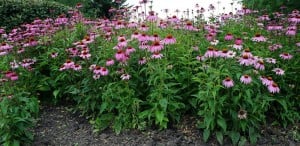Help Bring Back Pollinator Populations
Recently, we’ve seen an increase in attention focused on the plight of pollinators, in particular the honeybee. Honeybees are extremely important agricultural pollinators, while other native bees are also seeing population declines. The Rusty Patched Bumblebee is native to the Upper Midwest and was just added to the U.S. Fish and Wildlife Services endangered list. Many people have been asking us what they can do to help support local St. Louis-area bee, butterfly, and other pollinator populations.
Our short answer? Start by incorporating plant species that are both native to our region, and our perennial plants.
Below we’re sharing a few more pollinator-friendly steps anyone can take to help bring back important pollinator populations to St. Louis.
- Attract pollinators with resources. To attract pollinators, you’ll need to provide flowering plants with pollen or nectar. Diversity is important, because flowers with different colors and shapes will attract different pollinator species. Also, be sure to include species that bloom across the entire growing season (spring, summer, and fall). Native plants are what our local pollinators have evolved with, so they’ll always recognize and use them!
- Plant host plants. Just like monarch butterflies need milkweed to survive, other butterfly and moth species have particular plants they need to eat in order to develop. Use your own backyard to provide host plans that will ensure future generations of butterflies can mature. Read more about monarchs in the Midwest here.
- Avoid pesticide use. Outdoor pesticides are designed to kill pesky insects, yet sometimes they also unintentionally kill our pollinator friends. When you add plants to your landscape, make sure they haven’t been treated with systemic pesticides. And, if at all possible, make your entire property pesticide-free.
- Give pollinators a nesting site. Lots of insects like to nest in bare ground, leaf litter, or even hollow stems. Allowing some space in your yard to be a little less tidy can benefit local insects. You can also build or buy an attractive bee house that will add a fun design feature to your pollinator garden!
Helping pollinators starts in each and every St. Louis backyard. Native plants are critical to the survival or pollinator populations, and these native plants below are recommended by our horticulturalists to provide local bee and pollinator populations the resources they need:
Bergamot, New England aster, Stiff goldenrod, Prairie blazing star, American pussy willow, Purple coneflower. The landscape design team at Quiet Village Landscaping strives to incorporate native plants into each and every outdoor living design, and we’d love to discuss your ideas on bringing beautiful pollinators to your own outdoor spaces!

